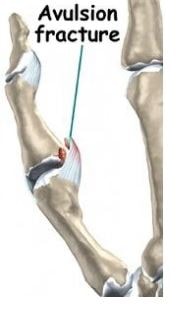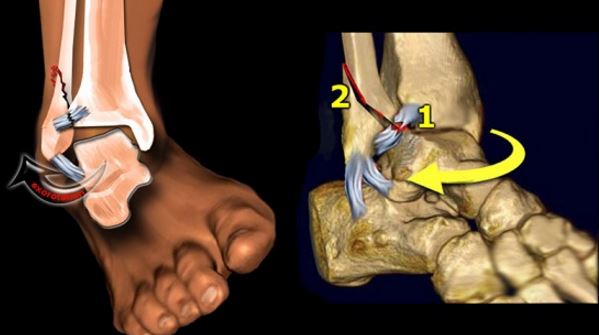Avulsion Fracture
What is Avulsion Fracture?
An avulsion fracture is clinically defined as a bone injury occurring in a location where a tendon or ligament attaches to a bone. Although it can happen anywhere in the body, this injury commonly occurs in a few particular locations [1].
In an avulsion fracture, a part of the cortical bone is removed from the bone by the attaching tendon. This occurs because the tendon is able to take in more force than the bone so it is more usual for the bone to be removed rather than the tendon [1, 2].

Figure 1 shows an illustration of an avulsion fracture.
Avulsion fractures are seen to be more common in children compared to adults because they have a weak point in their skeletal bones called growth plate. This part is growing actively and ligaments or tendons that are connected in this area are more prone to avulsion fractures. Athletes are at also at greater risk because of the sports injury that may have obtained [1, 2].
Most common locations
This fracture may occur anywhere in the body but it usually occurs in the hip, ankle and foot of an individual who engages in sports [3]:
Hip
In a hip avulsion fracture, a piece of the ischium bone is detached at the point where the hamstring muscle is connected. This fracture does not make the pelvic bone unstable or injure any internal organs near the hip [4].

Ankle
There are 2 leg bones (tibia and fibula) and 1 foot bone (talus) that make up the ankle joint. When an avulsion fracture occur in the leg bones of the joint, it may lead to a serious complication because of the ankle shift secondary to the bone instability [5].

Foot
A twisting injury to the foot may cause a fracture in the base of the bone where the little toe is attached. Portion of this bone is pulled by the ligament that is attached to it. This type of injury is also called a Dancer’s Fracture [6].
Causes
The primary cause of an avulsion fracture is a sudden pull on a tendon or ligament while its attached bone is moving in an opposite direction. There are two opposing forces applied on the bone and the tendon. A sprain will occur if the tendon or ligament is torn from the incident but if the bone cracks at the tendon attachment, it will result to an avulsion fracture [1].
Other possible causes of an avulsion fracture may include improper stretching and warm-up prior to performing exercises and bone problems such as infection and cancer of the bone. Traumatic incidents such as vehicular accidents may also cause avulsion fractures [9].
Signs & Symptoms
After the traumatic incident, the individual may experience a severe pain on the site of the injury. There may also be bruising and swelling on the same site. If the fracture occur in the ankle or foot, it will have a limited motion and it will be painful to mobilize the affected part. It is unable to bear any weight and will have a limp while walking [7].
Diagnosis of Avulsion Fracture
Health History and Physical Examination
In obtaining the medical history, the nature of the fracture should be identified. Although there are individuals who can’t remember how the injury occurred, knowing this information will help the physician assess for the stability of the affected bone. It will be also asked if there is any “pop” that may be heard during the incident and if there are any previous trauma that occurred on the same bone [8].
The physical examination will include a visual inspection and palpation to assess for tenderness in the affected area. Any crepitation that may be felt during this examination indicate a fracture and may need further testing. Resisted range of motion exercises will be performed to note the strength of the affected joint [8].
Imaging Tests
Imaging tests such as an x-ray will be requested by the physician to establish the diagnosis of an avulsion fracture. In the event that an x-ray failed to show the fracture, a different imaging test like a Magnetic Resonance Imaging (MRI), a Computerized Tomography (CT) scan or a bone scan to see the fracture [1, 8].
Treatment of Avulsion Fracture
RICE
Minor avulsion fractures can be resolved without any surgical procedures. The treatment that is done includes resting and applying ice on the affected area. The ice will assist in reducing the inflammation and pain in the affected joint. It should be done regularly for the first 2-3 days after the incident.
Exercises
Controlled exercises are performed to promote the healing of the bones, restore or improve muscle strength and bring back the range of motion. Crutches may be advised if the avulsion fracture is in the hip area. If the bone fragment is placed several centimeters away from the bone, a surgical treatment may be required. The procedure will re-attach the tendon and the displaced bone back to the source [1, 3, 9].
Surgery
For children, the avulsion fracture may involve the growth plates of the bone. This type of fracture should be corrected because it may affect normal skeletal development. Surgeries are performed to ensure that the growth plates are correctly aligned and stabilized [1].
References
- Cluett, J. (2016, February 6). Avulsion Fractures. Retrieved from About: http://orthopedics.about.com/od/brokenbones/a/avulsion.htm
- Luijkx, T., & Gaillard, F. (2015). Avulsion injuries. Retrieved from Radiopaedia: http://radiopaedia.org/articles/avulsion-injuries
- Laskowski, E. (2014, May 8). Avulsion fracture: How is it treated? Retrieved from Mayo Clinic: http://www.mayoclinic.org/avulsion-fracture/expert-answers/faq-20058520
- Dunbar, R., & Lowe, J. (2016, February). Pelvic Fractures. Retrieved from Ortho Info: http://orthoinfo.aaos.org/topic.cfm?topic=A00520
- New Health Advisor. (2014). Avulsion Fracture in Ankle. Retrieved from New Heath Advisor: http://www.newhealthadvisor.com/Avulsion-Fracture-Ankle.html
- Foot Education. (2015, July 26). Dancer’s Fracture (5th Metatarsal Avulsion Fracture). Retrieved from Foot Education: http://www.footeducation.com/foot-and-ankle-conditions/dancers-fracture-5th-metatarsal-avulsion-fracture/
- Children’s Hospital Colorado Orthoedic’s Institute. (2014). Pelvic Avulsion Fracture: Signs and Symptoms. Retrieved from Children’s Hospital Colorado Orthoedic’s Institute: http://orthopedics.childrenscolorado.org/conditions/pelvic-avulsion-fracture/signs-and-symptoms
- Kelly, J. I. (2015, October 21). Ankle Fracture in Sports Medicine Clinical Presentation. Retrieved from eMedicine: http://emedicine.medscape.com/article/85224-clinical#b4
- ePain Assist. (2015). What is Pelvis Avulsion Fracture? Retrieved from ePain Assist: http://www.epainassist.com/sports-injuries/pelvic-groin-buttock-pain/what-is-pelvis-avulsion-fracture
